In the 15+ years WPBeginner has been around, we found there are few things more frustrating than discovering that someone is stealing your content without permission and displaying it on their own website.
These individuals may monetize your hard work or divert your audience to their site, even outranking you on Google. This can result in reduced traffic and decreased revenue for you.
Luckily, there are effective strategies you can use to safeguard your content. For instance, you can limit access to your material by making it available only to subscribers. Plus, you can search for unauthorized use of your content and take steps to have it taken down.
In this article, we’ll show you how to protect your website’s intellectual property, such as your written content, images, and videos.
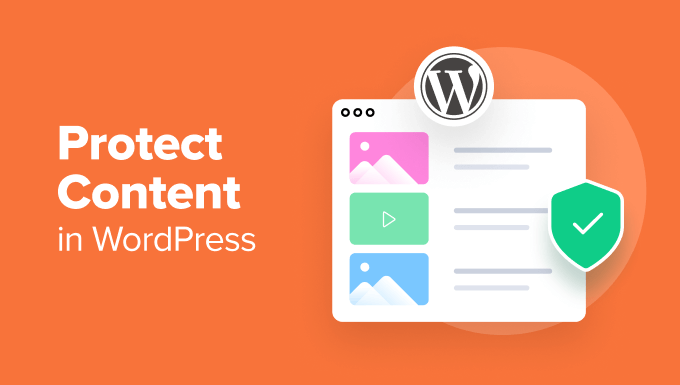
How Does Content Theft Hurt Your Bottom Line?
You work hard to create an effective content plan for your website that will attract the right visitors to your website. These visitors allow you to make money online as they purchase products and services, click ads or affiliate links, pay subscriptions, or make donations.
Unauthorized copying and scraping of your content can hurt your income and your reputation as a creator, brand, or business.
With that being said, let’s take a look at the best ways to protect your content in WordPress. Here are the topics we’ll cover:
- Copyright or Trademark Your Content, Business Name and Logo
- Make Your WordPress RSS Feed More Difficult to Scrape
- Password Protect Your WordPress Content
- Restrict Content to Registered Users
- Restrict Content to Newsletter Subscribers
- Disable Right Click and Text Selection
- Disable Hotlinking of Images
- Add Watermarks to Images
- Set a Canonical URL
- Scan the Web for Content Theft
- Block IP Addresses
- Issue a DMCA Takedown
- Bonus: Take Advantage of Stolen Content
1. Copyright or Trademark Your Content, Business Name and Logo
When you create a WordPress website, your content is automatically covered by copyright laws. This protects your intellectual property, brand, and business against legal challenges, plagiarism, and unauthorized use.
You should clearly display a copyright notice with a dynamic date on your website. This will make others aware that your content is copyrighted and may discourage them from stealing it.

Displaying a copyright notice will also help if you need to file a DCMA complaint to take down your stolen content. Later in the article, we will show you how to do this.
You can also apply for copyright registration online. For detailed information on that, check out our guide on how to trademark and copyright your blog’s name and logo.
2. Make Your WordPress RSS Feed More Difficult to Scrape
Your website’s RSS feed lets users keep up to date with your latest posts, but it can also be used by thieves to scrape your content. Luckily, there are a few changes you can make to your feed to protect your content.
First, you can configure your RSS feed to include only an excerpt instead of the entire article. Without the full text, content thieves will have nothing to steal.
You can find this setting on the Settings » Reading page of your dashboard. Simply select the ‘Excerpt’ option and then click the ‘Save Changes’ button.

The second thing you can do is delay posts from appearing in the RSS feed right away.
This will give time for Google to index the post on your own website and see you as the authority before the content can be stolen and published on other websites. As a result, your search rankings shouldn’t be penalized.
The easiest way to do this is using the pre-configured ‘Delay Posts in RSS Feeds’ snippet in the free WPCode plugin.

For more ideas, see our quick and easy tips to optimize your WordPress RSS feed.
3. Password Protect Your WordPress Content
One way to protect your most important content is to password-protect it. This lets you make some pages private while the rest of your site can be accessed by anyone.
WordPress comes with built-in settings to allow you to password-protect any post or page. From the content editor, simply change the Visibility setting from ‘Public’ to ‘Password Protected’ and then enter a strong password for the page.
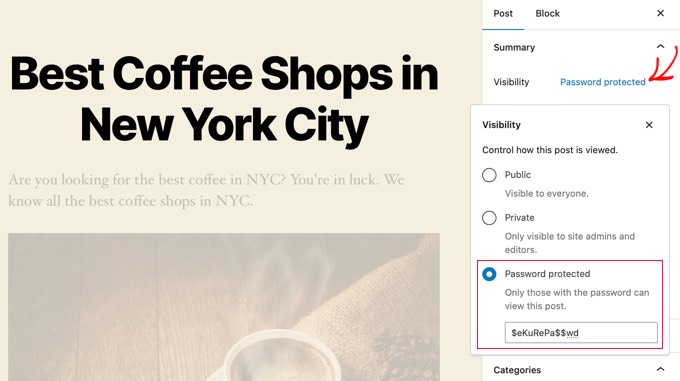
Once you publish or update the page, it will be protected so that only users who know the password can view it.
Once they enter their password, the page contents will be revealed.
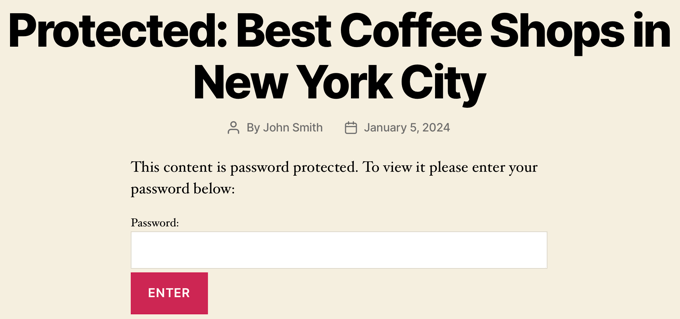
You can learn more about protected pages and how to customize them in our guide on password-protected pages in WordPress.
But there are problems with this approach. First, it can become difficult to manage all of the different passwords for protected pages. And second, once you give someone a password, you can’t control who they share it with.
You can use a free password plugin like PPWP or Passster to have more control when password-protecting pages. For example, they allow you to create a list of passwords to unlock content and expire passwords after a certain number of uses or a specific time interval.
With Passster you can also generate unique links that automatically unlock protected content and share them with certain users.
You can learn about these plugins in our guide on the best WordPress content protection plugins.
4. Restrict Content to Registered Users
Another way to protect valuable web content is to restrict it to registered users. This provides a better experience than using passwords because once a user logs in to your website, they will automatically be able to access premium content without constantly entering passwords.
A simple and affordable way to do this is with the free plan of Restrict Content Pro. This plugin allows you to create different access levels, accept payments, and restrict content by level or user role.

You can find step-by-step instructions on how to set up the plugin in our guide on how to restrict content to registered users in WordPress.
However, some very specific websites, such as membership and eLearning sites, restrict content to registered users. If you have a site like this, you may have a better experience by installing a plugin like MemberPress, which is designed for that exact type of website.
You can learn how to create these types of sites by following one of the guides below:
- Ultimate Guide to Creating a WordPress Membership Site
- How to Create and Sell Online Courses with WordPress (Step by Step)
- How to Create a Client Portal in WordPress
- How to Create a Paywall in WordPress (with Preview Options)
- How to Create a Pay-Per-View Site with WordPress
5. Restrict Content to Newsletter Subscribers
Alternatively, you can restrict content to newsletter subscribers. Offering access to locked premium content is a great incentive for users to subscribe to your email list, and it also keeps the restricted content out of the hands of potential thieves.
OptinMonster is the best lead generation plugin for WordPress. Its excellent content-locking feature makes it the best choice when using exclusive content to grow your email list.
When this setting is enabled, users will be able to see the first part of a post but will be prevented from viewing the rest of the content by showing a content-locking inline campaign. Once the user subscribes to the newsletter, the content is unlocked.
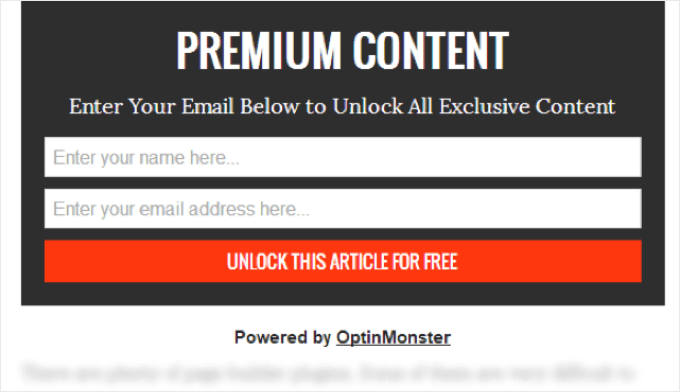
We show you how to configure OptinMonster for this task in our guide on how to add content locking in WordPress.
6. Disable Right Click and Text Selection
You can discourage manual copying of your content by disabling right-click and text selection on your website. However, this provides a poor user experience to anyone who wants to copy your text for other reasons, such as sharing your post on social media.
It also won’t stop tech-savvy users from copying your work because they can view your site’s source code or use the Inspect tool to copy a web page.
So, we only recommend you use this method if you feel it’s truly needed to combat content theft.
You can learn more in our guide on how to prevent text selection and copy/paste in WordPress.
We also have a guide on how to add no right-click on WordPress images that is incredibly useful.
7. Disable Hotlinking of Images
When someone copies content from your website, the actual images in the post are not copied, just the URLs to where to load those images.
This means that while the images are displayed on the other person’s website, they are, in fact, being loaded from your site. This is known as hotlinking, and you can stop it by adding a code snippet to your .htaccess file.
You can learn how to do this in our guide on how to prevent image theft in WordPress.
After that, the other websites will no longer show your images. Visitors will only see the alt text for each image, which looks like this.

This gives anyone reading your stolen content a poor user experience, which can, in turn, damage the thief’s reputation with visitors and search engines.
8. Add Watermarks to Images
If you have a photography website or portfolio, then you can protect your images by adding a watermark. A watermark is a semi-transparent logo, text, or pattern overlaid on top of your images.
Watermarks allow your users to view your photos, but they cannot download and use unmarked files without buying them.

This can prevent image theft by making it difficult to use your images without permission.
You can learn more in our guide on how to automatically add a watermark to images in WordPress.
9. Set a Canonical URL
A canonical URL is a WordPress feature that shows search engines the official (or canonical) version of a web page. This shows Google which page to prioritize in its rankings and can set you up as an authority on the topic.
Setting a canonical URL won’t stop others from stealing your content. But it will help search engines recognize your website as the original source, even if scraped content exists elsewhere.
This can potentially give your website a ranking advantage over any content thieves. It will also let Google know which article to index if your site has duplicate content.
The easiest way to properly set up a canonical URL is using All in One SEO (AIOSEO), the best WordPress SEO plugin on the market, used by over 3 million websites.
Tip: The Canonical URL feature is available with the free AIOSEO Lite version. There are also premium AIOSEO plans with more features to improve your SEO, such as schema markup, sitemaps, redirection manager, and more.
After you install and configure AIOSEO, you can simply scroll down under the content area of the WordPress block editor to find the AIOSEO Settings area. Once there, click the ‘Advanced’ tab.

Here you will find a field where you can type the canonical URL. In most cases, this will be the URL of the article you are editing.
10. Scan the Web for Content Theft
You probably won’t know if your content has been scraped or stolen unless you look for it. You can do this using a number of online tools.
One way to do that is using Google Alerts. Simply enter the name of your website and your URL, or use a portion of your article.

If you finish every blog post with the same call to action or other text, then you can set up alerts for that text and get notifications whenever it appears online.
Another tool is Copyscape. Simply enter the URL of your website, post, or page to see if it has been copied and stolen.

A third tool is Grammarly, the popular online grammar-checking tool.
The premium version has a built-in plagiarism checker. It can run scans to find matches online to your pasted content.

For detailed instructions on how to use these tools, see our guide on how to easily find and remove stolen content in WordPress.
11. Block IP Addresses
If you find that someone is stealing your content, you can block their IP address from accessing your website. However, this can be tricky because hackers typically use a wide range of random IP addresses from around the world.
That’s why we recommend you use a web application firewall (WAF) like Sucuri. This kind of plugin monitors your website traffic and automatically blocks common security threats before they reach your site.
However, advanced users can find the suspicious IP address by looking at the ‘Raw Access Logs’ in their web host’s cPanel dashboard. Take note of any IP addresses with an unusually high number of requests.

Next, you should check those IP addresses using an online IP lookup tool to find out more about it. You can block the addresses you are confident belong to content thieves by adding them to your site’s .htaccess file like this:
Deny from 123.456.789
You can add multiple IP addresses on the same line, separated by spaces.
For detailed instructions, see our guide on how to block IP addresses in WordPress.
12. Issue a DMCA Takedown
Finally, you can send a request to Google and other search engines to remove your stolen content on the internet in order to comply with the Digital Millennium Copyright Act.
But you should do this with care. Filing a report requires solid proof, and a false report can get your account in trouble.
There are a few ways to file a DMCA complaint, and we recommend Google Search Console.
First, you need to link your WordPress site with Google Search Console. You can learn how to do this in our guide on how to add your WordPress site to Google Search Console.
After that, you can use the Google Search Console Copyright Removal Tool.
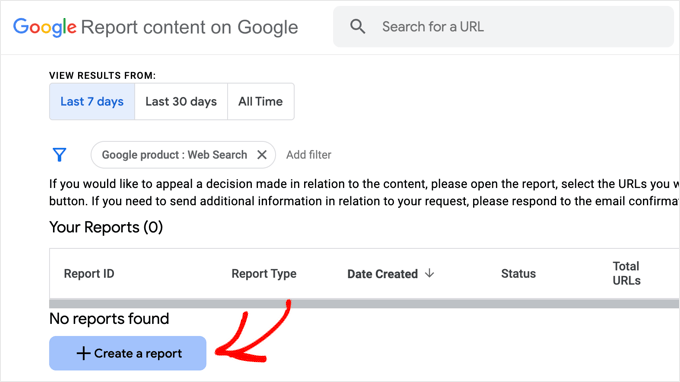
Simply click the ‘+ Create a report’ button and select ‘New DMCA report’ from the drop-down.
This will take you to a screen that explains what happens next and lets you add the relevant information such as your contact information, the posts that were stolen, and the URLs where you found them.
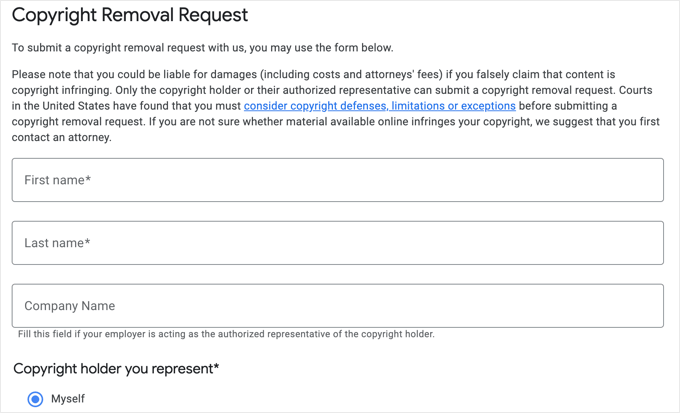
An alternate tool is the Digital Millennium Copyright Act (DMCA) tool which helps you both find and report stolen content.
You can learn more about both of these methods and much more in our guide on how to easily find and remove stolen content in WordPress.
Bonus: Take Advantage of Stolen Content
As you can see, protecting your WordPress content is a lot of work, and it becomes almost impossible to keep track as your blog grows.
That’s why, at WPBeginner, we also try to take advantage of websites that are stealing our content. If someone is going to post our content on their own site, then we try to make sure we can make money or gain traffic from it.
For example, we make internal linking an important practice. That means that any stolen content will contain many links that bring readers back to our own website. These links are also counted as valuable backlinks, which improves our SEO.
We also automatically add affiliate links to our content. These links will appear in the scraped content, so the content thieves help us make more money.
Finally, you can use the All in One SEO plugin to add a banner promoting your products and services to the footer of your RSS feed. The banners will also appear in the stolen content, giving your site free promotion.
We use the same method to add a disclaimer at the bottom of posts in our RSS feeds. This appears on the scraper’s site as well, letting users know that the site is stealing our content and signaling to search engines that we are the authority.
For further details, see the ‘Take Advantage of Content Scrapers’ section of our beginner’s guide on preventing blog content scraping in WordPress.
Expert Guides Related to WordPress Monetization
Now that you know how to protect content in WordPress, you may like to see some other guides on making money online and protecting your investment:
- Proven Ways to Make Money Online Blogging with WordPress
- How to Make $5000 of Passive Income Every Month in WordPress
- Low Cost and Easy Online Business Ideas that Make Money
- How Much is My Website Worth (REAL Value)
- How to Sell Your Website or Online Business
- How to Easily Find and Remove Stolen Content in WordPress
- Beginner’s Guide to Preventing Blog Content Scraping in WordPress
- Ways to Prevent Image Theft in WordPress
- Best WordPress Content Protection Plugins
If you liked this article, then please subscribe to our YouTube Channel for WordPress video tutorials. You can also find us on Twitter and Facebook.





Dennis Muthomi
I’ve been using the RSS feed delay trick a lot in my work, and it’s been a game-changer.
Here’s what’s really cool – I actually push the delay to 48 hours instead of 24. This gives search engines extra time to index the original content properly, and my subscribers still get fresh content through their feeds.
I’ve set this up for several business websites, and it works even better when you pair it with proper canonical URLs. This combo is super helpful when clients need to share content across different websites. My clients have seen way fewer issues with content scraping since we started using this approach.
Olaf
Wow, this is an incredible amount of information on how to protect website content—perfect! Unfortunately, we live in an age where technology enables digital criminals to commit theft, and content theft is all too common. It’s frustrating to spend weeks or months working hard to create quality content only to find it on foreign websites just because I underestimated content security. I believe that if someone really wants to steal content, they’ll find a way, but why make it easy for them? Huge thumbs up for covering such an important topic.
Samuel
Thank you so much for this incredibly written and insightful article. I learn a lots from this article today. One is how to copyright your assets. Most especially of interest to me is the delaying of rss feed to allow search engine to index it before allowing is a trick that blow my mind. A lot of solution offer here are new to me while other are trick hiding in plain sight. Thank you so much for this insight
Moinuddin Waheed
Thankfully I have not faced any such theft of content yet but considering the potential damage one can cause to the revenue and potential breach in your contents, I would love to implement these measures of content theft protection.
I can understand the pain and anger when one witnesses their content and hard work being misused on other platforms without due credit or credentials.
Thanks wpbeginner for bringing such a sensitive aspect to the fore and making a detailed guide on this topic.
Samuel
Please note that you wouldn’t if someone has stolen your content until you actually research it., As already mention in this tutorial you could use tools such copyscape or grammarly to scan the web for possible content theft.
Moinuddin Waheed
Thank you Samuel for your kind suggestions.
I have not used copyscape so far but have used grammarly and knowledge about its effectiveness in this regard.
I will definitely check this tool for more elaborate understanding of content theft and how it can be protected.
Mrteesurez
Thanks for the comprehensive guide on protecting WordPress content—it’s an invaluable resource for site owners. I’ve had my fair share of challenges with content scraping, and the tips on making WordPress RSS feeds more difficult to scrape are particularly helpful. Additionally, adding watermarks to images is a practice I’ve started implementing to safeguard my visual content from unauthorized use.
From my experience, these small yet effective steps go a long way in protecting your hard work. Ensuring your content stays yours is crucial, especially in today’s digital landscape. This guide offers practical solutions that can be easily implemented to secure your site. Thanks for sharing these valuable insights!
Jiří Vaněk
When I recently tried the Semrush tool, I was surprised to see how many external websites were stealing images from my blog by simply linking to them. According to Semrush, these are also toxic websites that are causing harm. Therefore, I consider content protection to be crucial, and it’s a pity I didn’t read an article like this at the start of my blogging journey. I might not have had to deal with these issues at all. Now I’ve applied many of your recommendations and am glad I found this site, as you’ve provided many valuable tips for protecting my content.
WPBeginner Support
Glad our tips have been helpful!
Admin